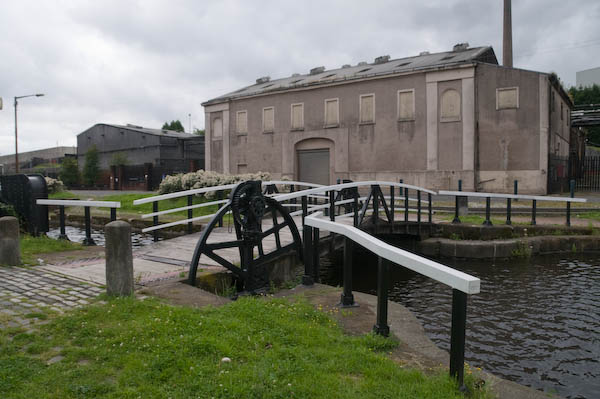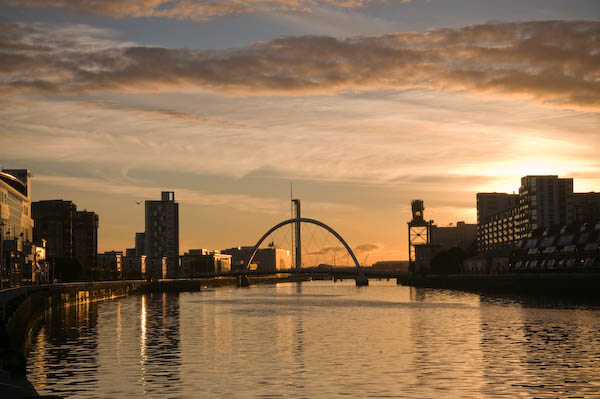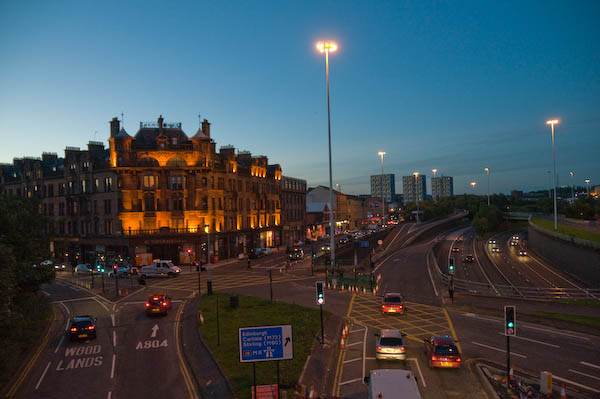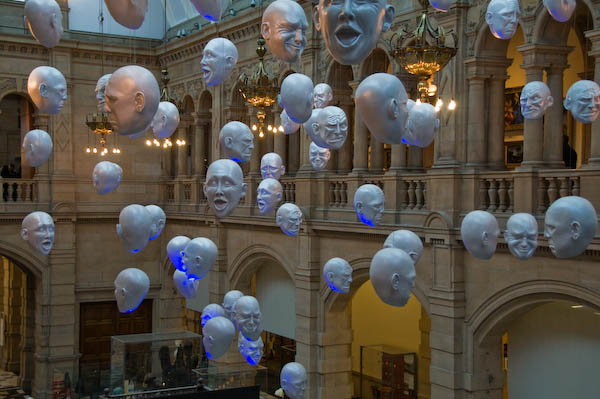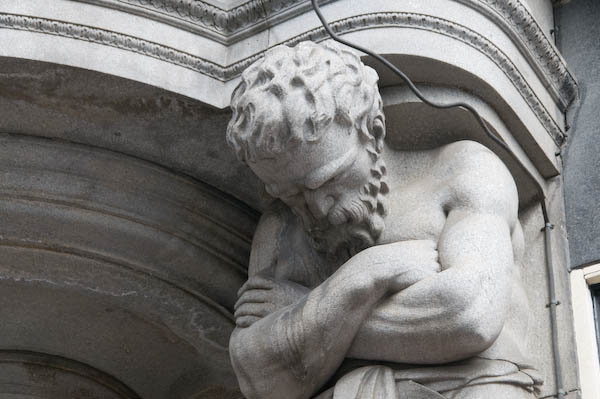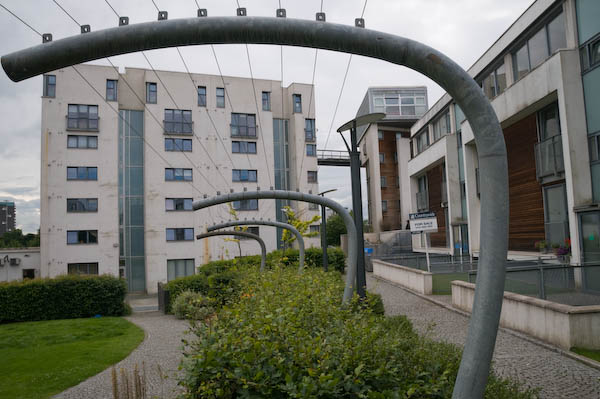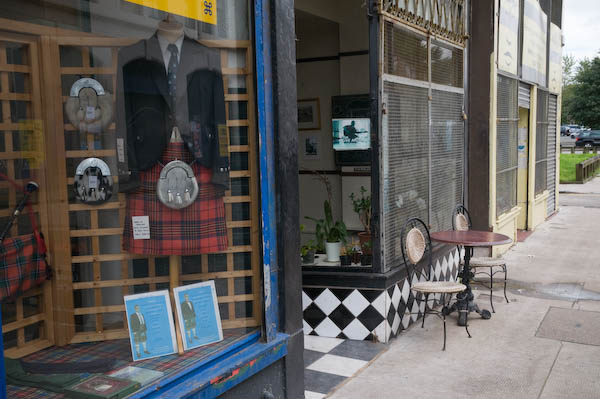Notting Hill Carnival
Notting Hill, London. Monday 25 August, 2008
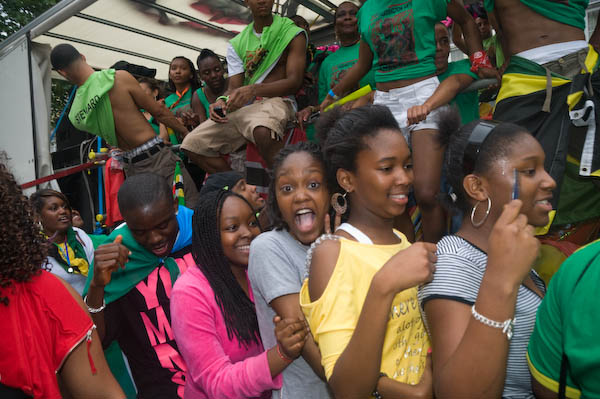
On Ladbroke Grove
more pictures
There isn't a great deal more to say about Notting Hill, although it did
seem to be significantly less crowded than in recent years (some sources estimate
attendance yesterday as three quarters of a million), and I walked easily
through a number of areas that have usually been filled with seething masses.
There did also seem to be fewer lorries and groups on the circuit than in
previous years, but the big mas bands at the core of the event were out in
force as usual.
Perhaps there are just too many other events on over the weekend and people
were tired. Perhaps with the difficult economic times there is less funding
for groups and less commercial interest (though Unison were still behind South
Connections.) The weather wasn't great either, though it didn't rain.
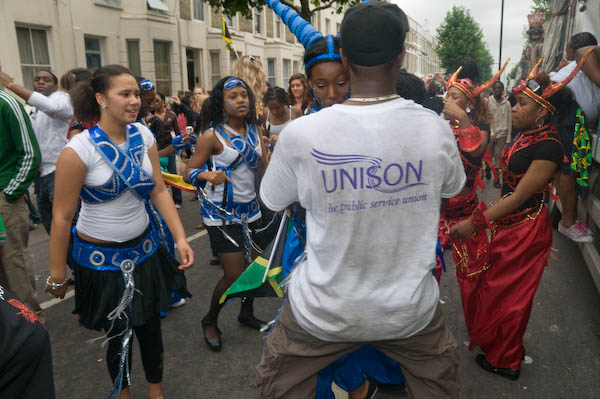
Of course there are still many people who won't go to carnival because they
are scared of possible crime and violence. Police have reported that they
had over 300 crimes reported to them at carnival on Monday and made around
150 arrests - considerably up on last year. With a reported 11,000 officers
on duty it was still probably the safest place in the country, although I
saw no sign of the metal detectors that were intended to prevent knifes being
carried. In around five hours I only saw one brief incident as a young man
was escorted away. The only knives I saw were plastic.
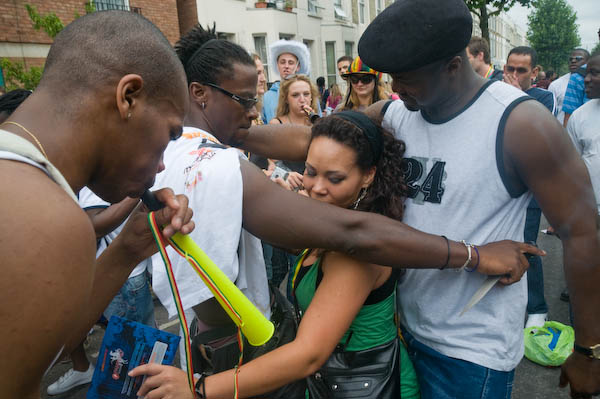
Of course carnival did go through troubled times. Its genesis was as a black
response to the race riots in Notting Hill fifty years ago, although it only
became a parade around the streets in 1965. In 1976 there was serious fighting
when 3000 police attempted to take over and control the event and had to withdraw.
Since then there have been various attempts to control and even stop carnival
in Notting Hill, including the organising of alternative events elsewhere.
And carnival itself has become much more managed and along with this, much
safer to attend
I first went to carnival and took pictures around 20 years ago and have returned
every year except one when a knee injury made it impossible (I made an effort,
limping from home to our local station where I collapsed, unable to climb
the footbridge, and decided I really wasn't up to it.)
In October I'm taking part in a show at the Juggler in Hoxton Market
(confusingly half a mile away from the site in Hoxton St where Hoxton Market
is held and I was photographing Sunday's '1948 Street Party'.) Hoxton Market
is immediately to the north of the Holiday Inn on Old Street. The show is
called 'English Carnival' and
is a part of the East London Photomonth 2008. The other 3 photographers, Paul
Baldesare, Dave Trainer and Bob Watkins, are showing pictures
from 'traditional' English carnivals - like the Hayling Island one at the
beginning of this month, but my pictures will be from Notting Hill - now,
along with other carnivals drawing their main inspiration from the Caribbean
- very much a part of the English carnival scene.
The work I've chosen to show is in black and white and a selection from a
portfolio of 20 images published in 'Visual Anthropology Review',
which accompanied a scholarly essay on carnival by a distinguished academic,
George Mentore who also made some perceptive comments on my pictures.
more pictures
Free Hackney Movement
Hoxton St, Hoxton, London. Sunday 24 August, 2008
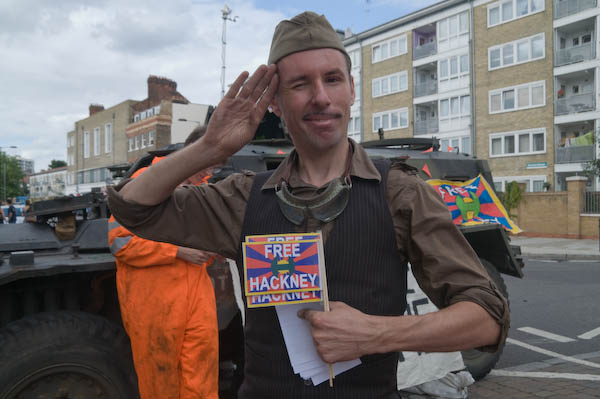 A
Free Hackney Movement salute in front of the 'tank' on Hoxton St
A
Free Hackney Movement salute in front of the 'tank' on Hoxton St
more pictures
The 'tank' from the Free Hackney movement drove to the 1948 Street Party
to celebrate the handover of the protest torch for the Olympics from the Free
Tibet protesters to Free Hackney.
The Free Hackney protest sees London 2012 as a great opportunity for property
developers to rip us off and make obscene profits building luxury flats in
the area, while at the same time restricting public access, closing down the
existing free facilities and demolishing social housing and local businesses.
So far its hard to argue against their case given the closure of local sports
facilities including the closure of the Temple Mills cycle circuit and the
removal of the Manor Gardens allotments and the wholesale clearance of small
local firms which were based on Stratford Marsh.
The Olympic development has so far been something of a catastrophe for the
area, and a lot has to be done to recover from this, let alone produce a positive
outcome for the area.
more pictures
Hoxton Handover - 1948 Street party
Hoxton St, Hoxton, London. Sunday 24 August, 2008
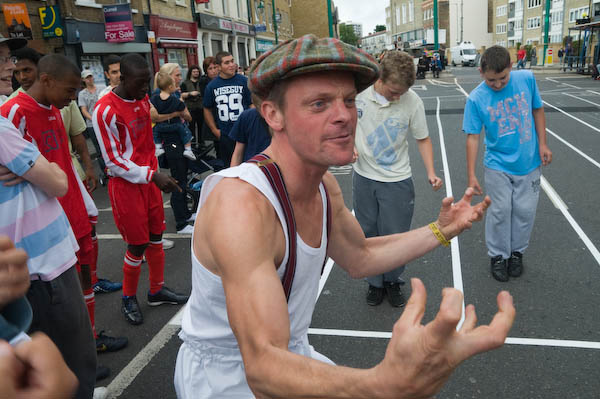
A critical point in the slow race at the Hoxton Austerity Olympics
more pictures
People in Hackney had put a lot of effort into a suitable celebration to
mark the handover of the Olympics to London. Hackney is of course one of the
three London boroughs which cover the main Olympic site, and one of those
which is hoping for some regeneration from the huge Olympic spend, though
past experience suggests that such hopes are probably largely misguided. And
with the government adamant to keep to the agreed budget, it is almost certainly
the 'legacy' that will lose most of the cash originally promised.
The big event was to be a '1948 Street Party' in the area of the road where
the market takes place, and there were shops, museums and various local organisations
taking part and putting on events and displays.
Unfortunately the council decided to create a rival event a few minutes walk
away in the part with a giant screen showing TV coverage from Beiking and
... well, and very little else.
The only real breath of life in the hour and a half or so I spent in the
park was a dance performance by local kids. Ebonessence were lively and fun.
Otherwise the deputy mayor waved his arms around, a DJ acted as MC and a few
people ran a 60 metre dash (one looked quite fast too) while a Chinese group
with flags and a lion were generally hidden in a corner and sidelined - though
perhaps they eventually got to give their display after I left.
Perhaps 500 people stood in a field that could have held 20,000 watching
a rather poor quality giant screen of a rather poor quality London advert
- in which the only point of interest for me was in seeing someone ride a
Brompton like mine. Two people, two, waved union jacks. Really there was little
that those present would have missed had they stayed in on the couch in front
of their own screens - where most would have got a better view of the events
in Beijing, though that might not have been preferable.
Hackney could and should have done much better - and just down the road it
was doing better. Just a shame that some people in the council thought they
had to stage this non-event to compete with the 1948 street party, rather
than think how the few positive 'Hackney' aspects could have contributed to
this.
So I went back to Hoxton St where things were infinitely more interesting.
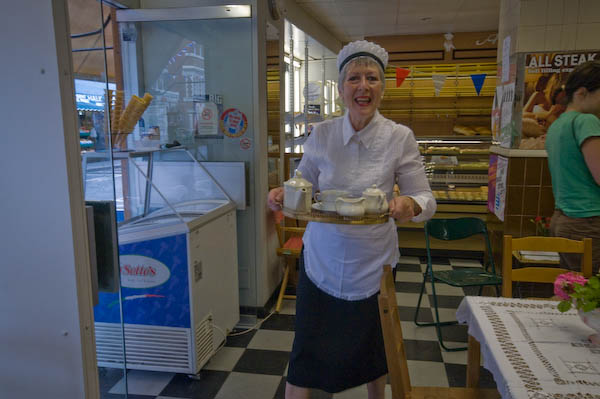
Earlier I'd had a very nice cup of tea served in 1948 style china by a "nippy",
and in the street were tea parties (with free cakes) and displays of boxing,
jitterbugging and various objects from the 1940s kitchen (almost all of which
we still use here, including a pastry blender - and no, it isn't used to make
bread.) Pearlies came in force and had a sing-song round the joanna.
Of course there was a bar, and there was also a little welcome madness in
the section of road where the Hackney Austerity Olympics was taking place.
It was of course highly appropriate, as the last Olympic Games held here were
very much run on a shoe-string in 1948, with a total budget of well under
a million pounds - allowing for inflation probably rather less than a hundreth
of the budget for 2012.
more pictures
Fingal's Cave and Staffa
Aug 13, 2008
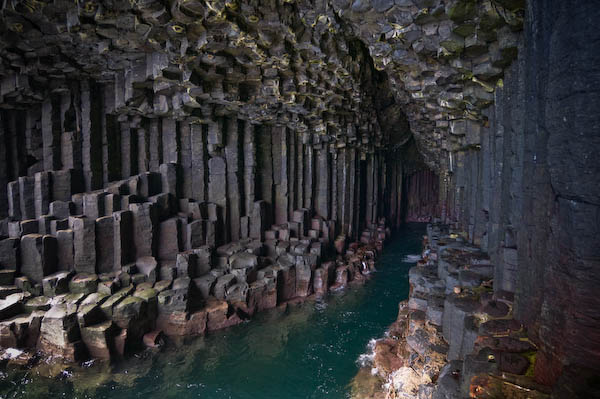
Fingals Cave, Staffa
more pictures
The boat from Iona takes around three-quarters of an hour to get to Staffa,
calling in to collect more passengers at Fionnphort on the way. It's a sea
journey of around is about an hour's sea trip by powerful fishing boat from
Iona, although the direct route is only about 8 miles. We got some glimpses
of basking seals on the shore of Mull and as we reached Staffa a couple of
sharks swam around our boat as we stood looking into the giant caves in the
south cliffs from the sea.
It was the great naturalist, Sir Joseph Banks, whose former house
in Spring Grove I used to cycle past daily on my way to school who named the
largest of these Fingal's Cave, linking them with the Irish giant who in legend
constructed a causeway starting from similar hexagonal basalt columns in Ireland
across to Scotland. Previously it had been known in Gaelic as 'the melodius
cave' (Uamh Bhin) from the sounds made by the waves lapping in its 150 foot
channel, echoed by the roof like a giant natural cathedral. Later as I approached
the cave on foot, the melodies I heard were distinctly female, but it was
truly disappointing to find they came not from mermaids but the a cappella
singing of my fully dressed wife and a few women friends.
Staffa is truly a magical and compelling place, and my only regret was having
to leave it so soon - just over an hour was nothing like long enough. Staffa
has had no permanent inhabitants since around 1800.
more pictures
Iona: the Weekly Pilgrimage
August 14, 2008
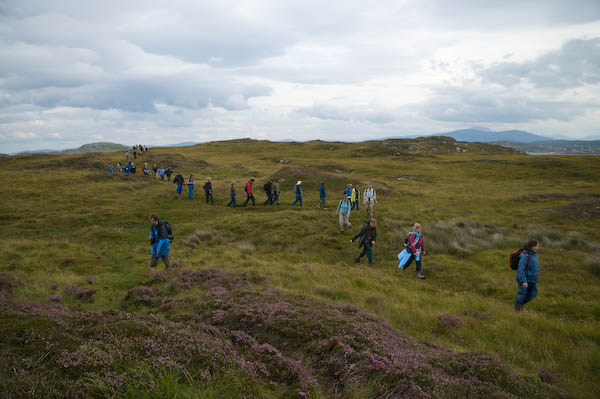
Every week the Iona Community invites everyone to make
a pilgrimage around the island
more pictures
Iona: the island
August 9-15, 2008
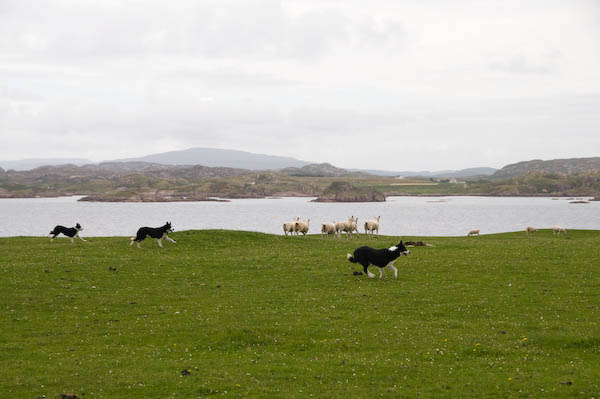 Dogs
rounding up sheep with view across to Mull
Dogs
rounding up sheep with view across to Mull
more pictures
Pictures from the rest of the island of Iona, which has some isolated crofts
and open ground with beautiful beaches and bays. Most crofters have to have
several occupations to make a living here. The permanent population of Iona
is now around 85 - while 150 years ago it was nearly 500.
Iona: the Village (Baile Mór)
August 9-15, 2008
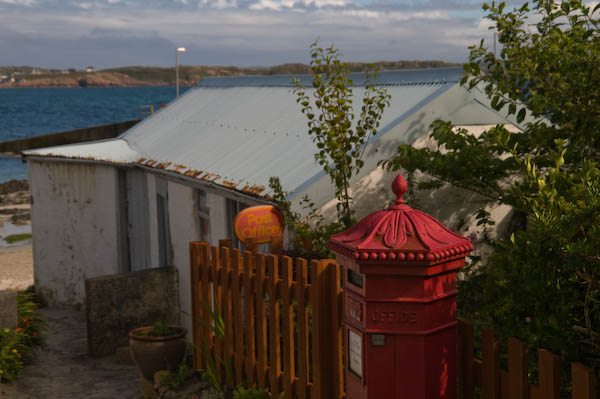
This must be one of the most photographed of post offices,
on the beach at St Ronan's Bay
more pictures
Pictures around the main settlement area on the east shore near where the
ferry lands at St Ronan's bay, where there is a street of houses, a couple
of hotels, a pub and a post office.
Iona: the Abbey
August 9-15, 2008
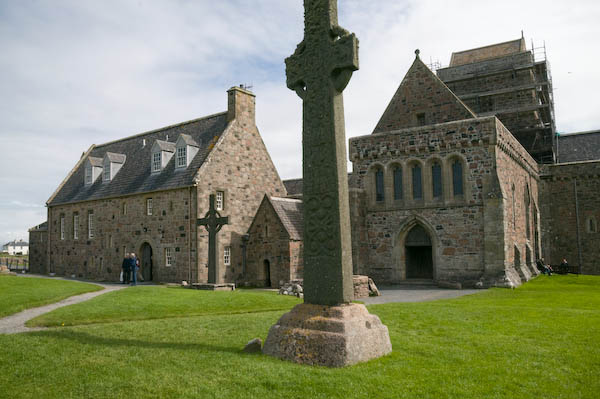
Iona Abbey
more pictures
The Abbey in Iona was in ruins when the 8th Duke of Argyll gifted it to the
church of Scotland in 1899, and some rebuilding took place in 1902-1910. But
the major part of the job was done by the Iona Community, a group
started in the 1930s in working class Glasgow by George MacLeod,
who brought together unemployed craftsmen and young ministers to start work
on it in 1938 - which continued until the work was complete around 1965. (The
scaffolding on the tower is to replace cement mortar which was used in the
early days of reconstruction with lime mortar, as the cement mortar is causing
damage to the stonework.
The abbey is now kept up by Historic Scotland, and the Iona Community are
still there as tenants who run various events there and in a newer centre
a couple of hundred yards away.) The black including the kitchens to the left
of the church is an almost entirely new building as little of the medieval
monastic stonework was still in place, and the St John's cross at left is
a concrete reconstruction - the original is in pieces in the museum.
We were guests of the Iona community, staying in the abbey, eating food cooked
in the kitchen, sharing in their daily services and the running of the place
as well as a small program of activities.
My contribution to the running of the place - as well as setting tables and
serving and clearing food (we were lucky in that the community has some excellent
cooks) was to chop vegetables - including more onions than you can imagine.
So although I enjoyed my stay, Iona to me will always be remembered as a place
of tears!
more pictures
The Journey: to and from Iona
Aug 9 and Aug 15, 2008
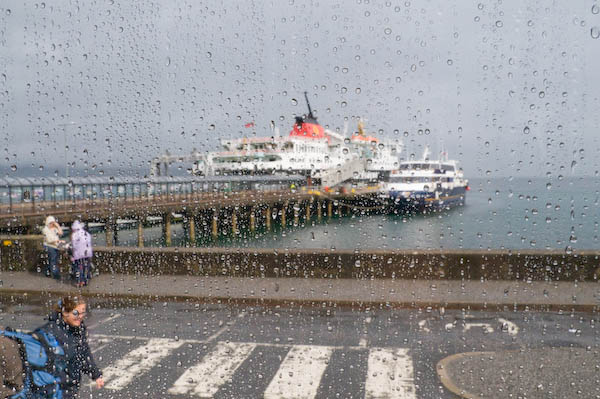
The ferry from Oban seen from the bus to Fionnphort, Craignure, Mull
more pictures
We started from our Glasgow hotel just after 8am, catching a bus to Oban,
roughly three hours, largely in driving rain that obscured the view. There
is a also a train, which takes slightly longer. At Oban we queued to buy tickets
for the ferry to Craignure and also for the second ferry which would take
us from Fionnphort on the other shore of Mull across the short distance to
Iona.
Fortunately we were among the first off the ferry and on to the bus at Craignure.
There are only two buses a day, timed to meet with two of the ferry journeys.
There were a few people who were left at Craignure to wait 5 hours for the
next bus, as the man in charge said "I'm not running a second bus for
nine people." It didn't look much of a place to wait 5 hours, even if
it had not have been raining.
The ferry for the short crossing from Fionnphort to Iona was much smaller,
and it goes back and forth fairly frequently during the working day; we had
around 20 minutes to wait and were on the island by 3pm where we were welcomed
and shown the way to the abbey.
Our journey back also took around seven hours, although this time the weather
was rather better and we could actually see the mountains we were passing
even if their tops were hidden by rain and clouds. From Glasgow we caught
the train back to London, getting home around 14 hours after we had left Iona.
more pictures
Glasgow - Forth-Clyde Canal
Glasgow - Clydeside Titan
Aug 8, 2008
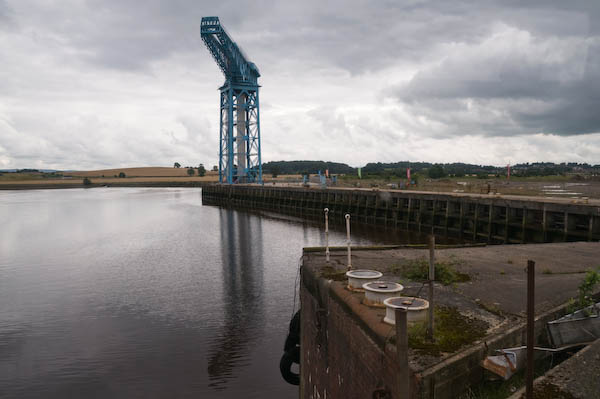
The finishing dock at Clydeside
more pictures
Glasgow - The Clyde
Glasgow - Roads
Glasgow Museums & Interiors
Glasgow - Sculpture
Glasgow Buildings
Glasgow - My pictures
I know it isn't London, but it makes a change - my pictures from a few days
holiday north of the border.
No New Coal Rally and March
Rochester, Kent. Sunday 3 August, 2008
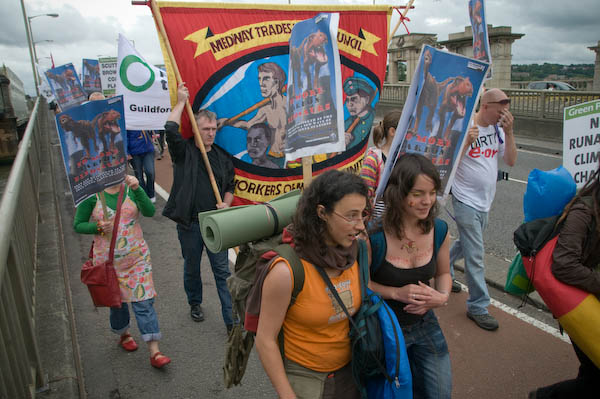
Marchers cross the River Medway at Rochester on the
way to the Climate Camp at Kingsnorth
more pictures
This year's Climate Camp was at Kingsnorth on the Hoo Peninsula in Kent where
E.ON intend to build a new coal-fired power station. Coal is the most polluting
of all fuels and this single plant will add more pollution than many whole
countries currently produce. The company and our government talk about carbon
capture and storage, but Kingsnorth will not incorporate these (just be ‘ready’
for them.) It is far from certain that these technologies will ever be developed
and even less likely if so that they will be economic.
One Climate Camp Caravan had started from Heathrow a week ago and another,
the Stop Incineration Climate Camp Caravan had been travelling from Brighton,
both demonstrating at various related sites along their routes and they met
on Sunday morning in the middle of Rochester for a 'No New Coal' Rally attended
by around 300 people.
Speakers at this included Ashok Sinha, Executive Director of Stop Climate
Chaos, Caroline Lucas MEP (Green Party), Deputy Director of the Kent Branch,
Campaign to Protect Rural England Sean Furey, Executive Director of the World
Development Movement Benedict Southworth, James Lloyd of People and Planet,
Penny Eastwood from the Camp for Climate Action, Medway Lib Dem councillor
Maureen Ruparel, Steve Wilkins from Medway Trades Council, Simon Marchant
from Kingsnorth Climate Action Medway and Phil Thornhill from the Campaign
against Climate Change and people from the Climate Change Caravans.
After the rally the marchers set off for the Climate Camp at Kingsnorth,
seven miiles away for the week of activities and action there. There was a
strong police presence, including some familiar faces from the Met, and I
noticed one police van which said it was from Staffordshire.
I left the march at the top of a long hill a couple of miles on, with just
under 300 people making their way to Kingsnorth.
more pictures
Hayling Island Carnival
Hayling Island, Hampshire. Sat 2 August 2008
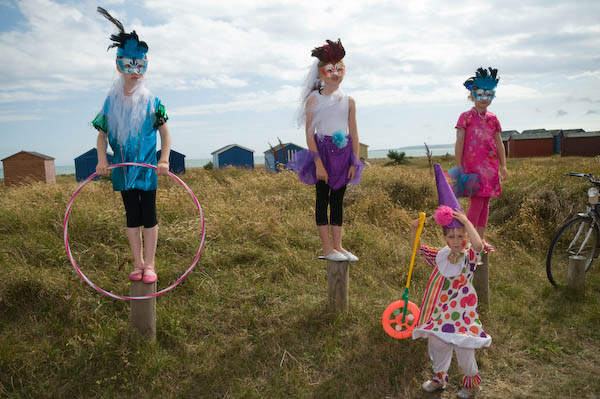 Waiting
to take part in the carnival procession
Waiting
to take part in the carnival procession
more pictures
Hayling Island is another part of 'London-by-the-sea' on the south coast
not far from Portsmouth and has a large carnival with fancy dress competion,
baby show, dog show, a carnival queen and princesses and a carnival parade.
I took many more pictures than are on show here - if anyone I photographed
can't find themselves here please contact
me and tell me what you looked like and were doing and I'll send
your picture if I have it.
more pictures
top of page
All pictures on this section of the site are ©
Peter Marshall 2008; to buy prints or for permission to reproduce pictures
or to comment on this site, or for any other questions, contact
me.

![]() the
island
the
island![]() the
Village (Baile Mór)
the
Village (Baile Mór)![]() the
Abbey
the
Abbey![]() the
Journey
the
Journey![]() Clydeside
Titan
Clydeside
Titan![]() Clyde
Clyde![]() Roads
Roads![]() Museums
Museums![]() Sculpture
Sculpture![]() Buildings
Buildings![]() My
Pictures
My
Pictures












